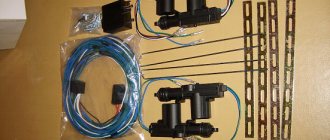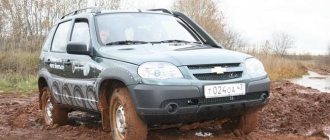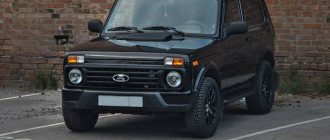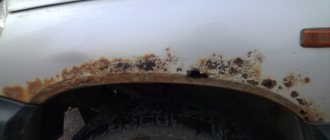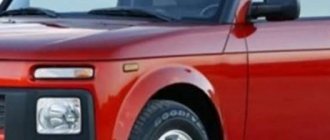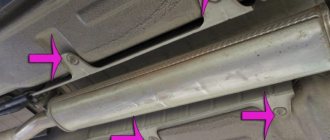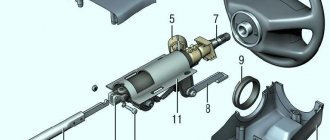I think it’s time to talk about the transfer case of the Chevy Niva, because those who just bought this car, at the very beginning of use, do not really know how to use the transfer case, what the rules are, and in general, when to lower the gear and when to lock it. Let's figure it out now. It’s a pity, of course, that I didn’t record a video on today’s drive along a fairly washed-out road. Well, never mind, I’ll record it and show it clearly on video. For now, in words.
In general, the transfer case switches to a lower gear, as well as to lock, and it is possible and even necessary to do this at the same time. It’s convenient on the Shevik - this is done with one lever.
Turn it down - right up. Add lock - Pull the lever all the way to the left. Look at the switch handle, it's written there. Letter designation - L (low) - low, N - neutral, H (high) - high, that is, normal.
How inter-axle locking works - read this article. There you will also learn about self-blocks - a real cool upgrade for the Chevrolet Niva, which will allow you to drive even further.
Well, now we’ll figure out when it’s better to turn it down, and when to also lock it. And how to do it correctly.
It looks something like this - we are driving across the field in normal second/third gear. Suddenly there is a terrible puddle ahead. We stop and turn down the car.
This is the first rule - when you engage the lower gear, you must definitely stop, that’s how the Shevik differential is designed. But the lock can be turned on and off without stopping. But do you need to always enable the blocking? It’s an interesting question and I’ll tell you what - I use it in exceptional cases, when the dirt is not out of the blue, but there are all sorts of potholes and where there is a risk of catching the “diagonal”.
You may ask - how long does it take to turn on the blocking and then turn it off? There is another nuance here - very often, many owners of the Chevrolet Niva have a problem with the blocking - it does not turn off. It just jams and that’s it, you have to drive on the highway with the blockage. This, you understand, is very harmful for the machine and in such cases you must turn it off.
How to turn off the interaxle? There are several options - turn on reverse, accelerate a little and try to dislodge the lock while driving. You need to do this at speed; it works quite often. Moreover, you can accelerate forward and also try to turn off the lock. I also got stuck once, but even then I didn’t notice it right away and it’s not a problem. Therefore, look at the on-board computer - when the lock is turned on, the following combination will “burn”:
In bright sunny weather it is sometimes difficult to see. Be careful. Well, about turning off the center wheel - I managed to turn it off just when reversing. Needless to say, now I turn it on only in the most dire cases. In the rest of the others, lower gears are quite enough for me.
Just today I went to the lake to check if the ice had melted. The road was washed out, the snow had already melted and turned into liquid mud, and it’s not safe to drive through such mud on my AT tires. It feels like it’s being dragged in all directions, but the most important thing is that I’m driving, I don’t get stuck, and sometimes the ruts were almost to the very bottom; when you shuffle, it always becomes unpleasant)) After some short drives, the car looked “military-like” - all covered in mud , went to the city - people look around))
And here’s another observation of mine: it’s better to drive through mud slowly but surely. This applies to lower gears - if the mud is serious, then I always drive in first, pushing hard, trying to feel the wheels spinning in the mud. If you accelerate a little, you can immediately “burrow”, this is the case when there is no hard covering under the liquid mud. This happens when driving through spring fields. That’s why it’s better to do it slowly, at first. Operate the pedal, don’t accelerate, feel how the car is really “rushing” - at first it feels great.
Well, a lot, of course, depends on the tires. Sometimes, if the tires are toothy, it is useful to accelerate so that the tread cleans itself. For Nivka and Shevik I highly recommend Cordiant Offroad tires, and if you have a little more money, then imported ones - Kumho and of course Hankuk Dinapro MT. Imported tires are more comfortable and are better for driving on the highway because they are soft. Well, in terms of cross-country ability, everything is also very cool here - after all, the tires are a Mud Terrain class, which means they are simply designed for mud.
When you turn on the second lower gear, the car accelerates, but if you get into a mud hole, there is a risk that the engine will “choke” (it is very difficult to spin the wheels in the second gear when stuck) and you will stall. Needless to say, stalling in a deep puddle can be dangerous. Therefore, if you decide to overcome a puddle or muddy area with acceleration (very often this makes sense), then be prepared in the middle, if you suddenly start to fall through, immediately switch from 2 to 1 low, so as not to stall.
Overcoming fords and puddles
Attention
- When driving through water obstacles, you need to be extremely careful, as they can hide holes or underwater obstacles that can damage wheel rims or suspension parts. It is not allowed to overcome water obstacles with a depth of more than 0.3 m. Entering water and wading should be done carefully, avoiding the formation of a wave in front of the radiator grille, since in this case water may enter the engine through the air intake of the air filter. This will inevitably lead to engine failure.
- To prevent water from entering the ignition system due to the operation of the electric fan, the air conditioner must be turned off before overcoming water obstacles.
After long-term operation of the vehicle in water, it is necessary to check the penetration of water into the crankcases of the front and rear axles, and if necessary, change the oil.
Warning. Exercise special attention and caution in the first minutes after the rain begins, as moistened dust on the road surface forms a slippery film, which sharply reduces the grip of the tires on the road.
Regularly while driving, lightly slow down the car to dry the brakes, as the effectiveness of wet brakes decreases sharply.
When overtaking, turn the windshield wiper to maximum mode - this will help avoid loss of visibility due to the possible release of water from under the wheels of the vehicle being overtaken. It is advisable to apply such precautions even if you are overtaken.
Do not overtake in rainy weather if a cloud of water from under the wheels of the car in front completely blocks your view of the overtaking area.
To avoid driving in the plume of water from cars in front, increase your distance and reduce your speed.
When driving along sidewalks during or after rain, or when driving through puddles, reduce your speed so that splashes from under the wheels of your car do not fall on pedestrians.
The correct distance is a guarantee of safety
Everyone knows that the braking distance on a slippery highway increases several times, but not everyone wants to remember this. In winter, when driving on the road, you must keep your distance.
The distance to the car moving ahead should be 2 times greater than in the summer. Only at such a distance can you safely brake without causing harm to the stopped or moving car in front.
You also need to be extremely careful in your attitude towards pedestrians crossing the road or walking along the side of the road.
Traffic in winter
Warning. Be very careful on wet or slippery roads - avoid sudden braking and sudden pressing and releasing of the accelerator pedal. Drive the car smoothly, without sudden movements of the steering wheel. Reduce speed only by gradually shifting to lower gears with partial braking using the service brakes. If, no matter what, the car begins to skid, turn the steering wheel in the direction of the skid and smoothly use the steering wheel and gas pedal to level the car.
At road intersections, ice often forms due to wheel slipping when starting off. Therefore, when approaching such places in advance, on a dry area, begin to reduce your speed.
In winter, it can be difficult to move away from a slippery area. To do this, engage second gear and, slowly releasing the clutch pedal, gradually increase engine speed. In some cases, it is useful to lock the center differential before driving.
How to turn on all-wheel drive on a Niva
The Niva has permanent all-wheel drive. What does this mean? What the Niva all-wheel drive scheme means is that it always works - all four wheels constantly receive rotational energy from the engine through the cardans and differentials.
The information that on a Chevrolet Niva and Niva 4x4 you can turn off and turn on all-wheel drive with a lever is a very common myth . This version is sometimes voiced even by managers of Lada dealers - supposedly the transfer case lever connects the front axle, connecting all-wheel drive. In fact, the Niva has permanent all-wheel drive, not plug-in one!
The most common argument in favor of the wrong theory is why, with the transfer case turned off, if you hang one wheel on the Niva, the car will not move? For example, in this video they talk about the “floating” and unstable all-wheel drive of the Niva.
Whether the Niva has permanent or non-permanent all-wheel drive (see from time mark 2.40)
The answer is simple - because this car, in both generations, uses free, non-locking differentials. How it works - read the corresponding material. Therefore, when the wheel is suspended, all the engine power is spent on its rotation, and the other three wheels practically do not rotate.
Why then does turning on the transfer case lever help when off-road? Is it because it “turns on” the Niva’s all-wheel drive? No, this lever locks the center differential. As a result, the engine power is not sent to the wheel that spins the easiest (in accordance with the principles of the differential), but is distributed equally between the axles. And one of the axles is able to pull the car out.
By the way, if a Niva has a wheel stuck/slipped on each axle, the car will not be able to get out of this situation. In this case, only blocking each of the wheel differentials would help, but this car does not have it. Although such a device can be installed additionally.
Therefore, there is no need to ask the question “how to turn on all-wheel drive on a Chevrolet Niva, Niva 2121 or 4x4, because it is already turned on. But you need to use the locking capabilities of the center differential. Let's look at how further.
In the mountains
Attention. When driving uphill, switch to lower gears in a timely manner, avoiding overloading the engine and jerking the car. If necessary, engage a lower gear in the transfer case.
On long descents, use the engine in braking mode with partial use of the service brakes.
Warning. Do not descend with the clutch disengaged and using only the service brakes. This will cause the brakes to heat up and the brake fluid to boil. Keep in mind that as altitude increases, the boiling point of brake fluid decreases. The boiling of brake fluid in the wheel cylinders means a complete failure of the service brakes - the brake pedal sinks.
In mountainous areas, keep to the right side of the road. The narrower road width and complex route profile require more attention and caution. When turning, give sound and light signals. When stopping on an uphill or downhill slope, turn the steering wheel all the way so that if the car starts moving spontaneously, its wheels will rest against the curb of the road.
On slippery roads, do not start driving up a steep hill until the vehicle in front has reached the top.
Lada-Niva. Off-Road Sermon (Part 4)
We continue to publish Sergei Mishin’s materials on the features of driving a Niva car.
DRIVING ON THE SAND
Whatever they say, sand is one of the most treacherous types of off-road: it is difficult to name a surface that would cause so many troubles for motorists. Yes, digging a car out of a sand dune is more pleasant and easier than from a mud swamp - there is no doubt about it, and this is perhaps the only positive point. Another difficulty in overcoming sandy areas is that success here depends not only on the driver’s skills, but also on the equipment of the car and its individual characteristics.
It is worth recognizing that the Niva is generally larger, and with a 1600 cc engine. cm - in particular, it feels uncomfortable on the sand: the high-speed VAZ-2106 passenger engine does not indulge the driver with torque. Upgraded 1700 cc engine. cm (especially with a fuel injection system) in this sense is noticeably better, and yet diesel has the most optimal performance from the point of view of traveling on sand - the ability to produce high torque at low speeds comes in handy here.
But a high-torque engine is not everything. The most important thing is the tires. It is they who play the most important role when moving on sand.
Unfortunately, the range of domestic off-road “footwear” for the Niva is very scarce: until recently, only two tires were on sale - the “mud” VLI-5 and the universal VLI-10. It should be borne in mind that neither one nor the other provides reliable movement along the sand; however, if there is nothing else to choose from, it makes sense to choose a tire with a universal pattern. If, for a number of reasons, you are forced to leave VLI-5 tires on your car, do not forget to reduce the pressure in them to one atmosphere.
In general, for sand it is better to have imported tires - wider and softer. If possible, choose a tread pattern that is not “evil”, because developed lugs on loose soils only cause harm: in case of slipping, they help the car to bury itself up to its “belly”.
Now let's talk about the technique for overcoming sandy areas. Remember the main rule: no matter how harmless the sandy “bald patch” may seem to you, always and be sure to engage the differential lock and low gear in the transfer case in advance.
It is better to walk through small areas of sand. Keep the front wheels straight at first, and attempt to turn (of course, only if necessary!) only when you feel that the Niva is moving confidently without losing speed. Always try to turn very smoothly, with a large radius.
A very typical mistake: when storming a sandy slope, under no circumstances allow the Niva to fall on its side!
If you have the opportunity to choose, it is better to move on wet sand: the higher its humidity, the denser it is and, accordingly, has less resistance to the rolling of the wheels. It is for this reason that it makes sense to cross the coastal sections of reservoirs, moving closer to the water. And God forbid you frolic on the beach! Fountains of sand from under the wheels look, of course, very beautiful, but the end of this kind of ride is not the most pleasant - digging out the car can take half a day.-
Since you still decide to frolic in this way, make sure you have a long rope, a shovel and a tractor
But even in a wet area, where the Niva moves more than confidently, you may be caught in a trap in the form of “quicksands” or “quicks.” Keep in mind that stopping on a sandbank leads to the car being quickly sucked into great depths, and, as a rule, it is not possible to get out without outside help. There is only one way out - to overcome such sections at the highest possible speed, having previously reduced the air pressure in the tires to 0.8-1 atm. And under no circumstances stop!
| For a forced stop, choose these “oases” |
On loose sand, try to cling to any, even inconspicuous, islands of vegetation with your wheels, and if you can see a track laid by someone, be sure to use it - the sand here is compacted. Do not forget, however, to compare the depth of the track and the amount of ground clearance of the Niva.
If a situation arises where you need to stop, do it on a slope or an island of greenery. After this, start off in first gear (using, of course, the lower row of the transfer case), very smoothly releasing the clutch pedal and holding the minimum stable engine speed. If you feel that the Niva has moved confidently, engage second gear, but you shouldn’t go further than that on dry sand. Moreover, you should not use the upper row of the transmission, even if the car is moving with a clear reserve of traction: if road conditions suddenly worsen (you hit quicksand, for example), the engine will begin to “chop” and, in order to increase the torque on the wheels, you will have to use a range multiplier . It will not be possible to do this without stopping, and stopping, as we have already found out, is fraught with big troubles.
In the most extreme case, when movement is very difficult, try reducing the pressure in the wheels even more, to 0.5-0.8 atm.
This is the lower limit at which a tube tire can operate, so when starting off on low tires, be doubly careful: the tire can spin on the rim and tear the tube.
After driving through a dangerous area, do not forget to bring the pressure to normal.
The most important thing when storming sandy slopes is to overcome the obstacle with a reserve of speed, “head-on”, and avoid positions where the car is tilting heavily. Significant rolls lead to heaps of sand sliding and heating in front of the wheels.
If possible, try to move on wet sand
When performing any maneuver, launch the Niva at its maximum radius
Well, what if you finally “sat down”? If the wheels are buried in the sand and the Niva has stopped moving, do not skid under any circumstances - you will only make things worse. Try clearing the sand in front of all the wheels. Fortunately, you can rake sand with more than just a shovel.
If this does not help, you can resort to using a jack. Place a board or several stones under its support platform and, hanging out all the wheels one by one, place branches or boards under them. Please note that you should move off carefully after this so as not to throw them out from under the wheels.
As soon as you move, gradually add gas. so that when driving onto the sand there is already a reserve of speed.
DRIVING IN MUD
Let's immediately agree that by the concept of “dirt” we will mean wet and slippery soil (chernozem, clay, etc.) of varying viscosity.
This is the most common off-road option in Russia - something, and we have enough dirt everywhere.
The “toothy” VLI-5 tires perform best in mud, but with some experience, the universal VLI-10 tires can be used quite successfully.
When driving on a wet dirt road, it is best to use the upper row of the transmission, and you should only lock the differential on ups and downs, because in all other cases, the engaged lock will significantly complicate the Niva’s handling. Try to start and accelerate smoothly, avoiding wheel slipping, and move in a straight line “pull”, in the highest possible gear - this will prevent the transfer of excess torque to the wheels and their slipping. Brake smoothly, avoiding wheel locking, by combining pressure on the brake pedal with sequential downshifts.
If the nature of the terrain has changed and you find yourself on a broken road, feel free to turn on the lock: after all, when jumping over bumps and holes, there is a possibility of unloading one of the wheels and, as a result, a dangerous reduction in traction.
The signal to begin an active fight against dirt is the moment when the Niva stops pulling confidently in second gear of the top row of the transmission. Your actions in such a situation should be as follows. Stop in a place where you are guaranteed to be able to move off and, turning on the range, leave second gear engaged - in the event of a sharp deterioration in driving conditions, this will allow you to switch to first (lower) gear without stopping. In addition, now instead of one, you have three transmission stages at your disposal, the gear ratios of which are lower than the second increased one. More gears mean more room for maneuver.
If you don’t plan to drown the Niva in the mud, force yourself to take your time
And you can maneuver when taking very heavy “mud baths” in two ways. The first is classic, universal. It is suitable not only for Niva. The lower row of the transmission is engaged, first or second gear in the gearbox and very low throttle. The engine speed is either equal to the idle speed (do not press the gas pedal), or a little more, but does not exceed 1500-2000 rpm. The car, as it were, overcomes a difficult section on its own, crawling through it “pull”, and the driver is only required to operate the steering wheel in a timely manner.
As a rule, if you get stuck, you can drive back without any problems.
Unfortunately, for the Niva, this method is not always applicable - after all, let us remind you that carburetor engines often lack low-end torque, so we can only recommend using the classic method of overcoming difficult muddy sections to owners of diesel and injection-powered Nivas (VAZ- 21215 and VAZ-21214).
The second method is dynamic or, if you like, “Nivovsky”. It is based on the use of the kinetic energy reserve of a moving car. This method is most suitable for carburetor cars - VAZ-2121 and BA3-21213, but can also be used on injection versions. It is impossible to use the dynamic method on a diesel engine.
The “piloting” technique is as follows: having set off, we try to smoothly spin the engine until it roars sharply and signals the beginning of intense wheel slipping. We gently release the gas pedal and, feeling that the wheels are again beginning to confidently cling to the ground, we fix our foot in the ankle for a few seconds so that the Niva gets at least some acceleration. Again, smoothly press the accelerator pedal, monitor the moment the slip begins, close the throttle again, fix the foot, and so on. It turns out that you are constantly monitoring wheel slip and constantly “testing” the coefficient of adhesion.
By the way, the dynamic method of propulsion makes it possible to practically equalize the capabilities of the VLI-5 and VLI-10 tires in mud, with the exception of the car’s ability to drive out of a rut.
If your path lies on a road with a variable profile, and the rolling resistance of the wheels changes, it will be better if you “track” the change in road conditions using the accelerator pedal. So, you should add gas on small descents and when entering thick mud, and release it slightly when going uphill and in places where you exit mud and holes in order to avoid slipping.
Maintain the speed so that the car can move confidently and, most importantly, evenly. Don’t get too carried away, remember that the higher the speed, the more intensely you will have to work with the steering wheel during maneuvers.
If, despite active attempts to overcome the obstacle, the Niva suddenly loses speed, it is better to squeeze the clutch and let the car stop on its own. Then engage reverse and, avoiding wheel slip, move backwards. Remember that it is easier to prevent wheel slipping with a higher transmission range.
It happens that in extreme conditions you have to make a road in thick mud with short throws forward, using your own track to accelerate. The main thing here is not to overdo it with acceleration: make your way carefully, going back two or three meters, no more. When you hit the untouched dirt, depress the clutch - this will prevent unnecessary wheel spin and reduce the likelihood of getting stuck. Force yourself to take your time: it is better to make a rut several times half a meter at a time than, having flown two times at once, to firmly “plant” the car. Well, if this sad fate has not escaped you, do not panic and analyze the situation.
If, when trying to move back and forth, the Niva “moves” at least in the range of 5-10 centimeters, then it will get out on its own. Using (if possible) the top row of the transmission, rock the car, alternating first and reverse gears. Starting should be smooth, without slipping. Direct the front wheels along the track, and if there is none, set it straight. Try to notice in which direction the car “goes” more readily. Does it continue to move slowly, or does it stop due to slipping? If it stops, depress the clutch a little before the advance limit line, engage the opposite gear and try to do the same in the opposite direction. If you notice that the car has increased the swing amplitude, feel free to press the accelerator pedal, rev the engine to 4500-5000 rpm and wait until the Niva takes you out of the dangerous area.
In the case when a stuck car is not able to make independent “body movements”, there is only one way out: use the tractor or passengers as additional “traction force”, and in the absence of these, arm yourself with a shovel.
Video
Power steering
The car is equipped with power steering, which significantly reduces the force on the steering wheel. If the power steering is not functioning (for example, when towing a vehicle with the engine not running), you can still steer the vehicle, but you will need to apply significantly more force to the steering wheel to do so. In extreme positions of the steering wheel, functional noise is allowed.
Warning
- Do not coast with the engine not running! In this case, the power steering does not work, putting you and other road users at risk.
- It is not allowed to hold the steering wheel in extreme positions for a long time.
How to brake correctly?
Worse than icy conditions is slippery asphalt covered with a thin layer of snow.
Studded tires are designed to improve the grip of wheels on ice, but when the ice crust is covered with snow, the studs are ineffective because the snow sticks to them and the rubber slides heavily on the asphalt.
It is necessary to brake on such a track impulsively, without allowing the wheels to completely lock.
Pressing the brake for 4-5 seconds prevents the ABS from working, which doubles the braking distance of the car on an icy crust.
You should not press the brake suddenly to avoid prolonged sliding on the road.
Riding on ruts
The biggest problem on a winter road is the ruts. When a car moves even at low speed along a track, it can skid.
Under these conditions, the driver must constantly keep his arms tense to allow the car to rock slightly (yield steering) but control the speed and position of the steering wheel.
If the rear end skids on a front-wheel drive car, you need to increase the speed, and on a rear-wheel drive car, reduce it a little, but do not brake.

